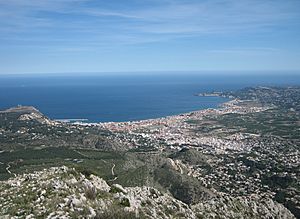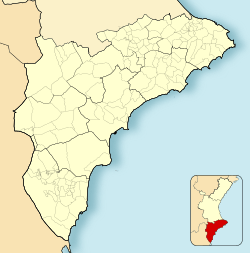Xàbia facts for kids
Quick facts for kids
Xàbia
Jávea/Xàbia
|
||
|---|---|---|

View of Xàbia from Montgó massif
|
||
|
||
| Country | ||
| Autonomous community | ||
| Province | Alicante | |
| Comarca | Marina Alta | |
| Judicial district | Dénia | |
| Area | ||
| • Total | 68.59 km2 (26.48 sq mi) | |
| Elevation | 12 m (39 ft) | |
| Population
(2018)
|
||
| • Total | 27,224 | |
| • Density | 396.91/km2 (1,027.99/sq mi) | |
| Demonym(s) | xabienc, xabienca (va) javiense (es) |
|
| Time zone | UTC+1 (CET) | |
| • Summer (DST) | UTC+2 (CEST) | |
| Postal code |
03730, 03737, 03738, 03739
|
|
| Official language(s) | Valencian and Spanish | |
Xàbia (Valencian: [ˈʃabia]) or Jávea (Spanish: [ˈxaβea]) is a beautiful coastal town in Spain. It is located in the Valencian Community, by the Mediterranean Sea. Xàbia is found in the Marina Alta area of the Alicante province.
The town sits near the Montgó Massif, a large mountain. It is also protected by two rocky headlands. Xàbia has become a very popular place for holidays and a busy market town. Many people from other countries live here or visit every year.
Contents
History
Ancient Times in Xàbia
People first lived in the Xàbia area about 30,000 years ago. These early cave dwellers lived on the Montgó mountain. Over time, many different groups settled here. These included people from the Stone and Bronze Ages.
Later, Romans, Greeks, and Phoenicians also lived in Xàbia. The Romans used the port for fishing boats. We know that Romans were in Xàbia as early as the 2nd century BC. This makes Xàbia the oldest known Roman site on this coast with a port for trade.
Medieval Period and Pirates
From about 714 AD, the Moors controlled the area. They were finally asked to leave the Alicante region in 1609. Not much of their culture remains today, except for some old gravestones and pottery.
In the 16th and 17th centuries, pirates often attacked coastal towns. To keep the town safe, a strong wall was built around Xàbia. This wall was later taken down. Today, you can see parts of a new wall that looks like the old one.
Amazing Discoveries
In September 2021, archaeologists made an exciting find in Xàbia. They discovered a hidden collection of 50 gold coins from the Roman Empire. These coins were about 1,500 years old!
The coins were in great condition and easy to read. They showed pictures of Roman Emperors like Valentinian I, Theodosius I, and Honorius. These amazing coins will be cleaned and then shown at the Soler Blasco Archaeological and Ethnographic Museum in Xàbia.
Geography
Location and Landscape
Xàbia is located in the northern part of its province. It is the easternmost point on Spain's Mediterranean coast. On clear days, you can even see the island of Ibiza, which is about 90 kilometers away.
Inland from Xàbia, you will find flat, rich farmland. Small streams flow through this land, which is mostly used to grow citrus fruits and olive trees. Xàbia's coastline has four main capes, which are points of land sticking out into the sea. These include Cabo de San Antonio and Cap de la Nau, which is the largest.
Natural Park
The Montgó Massif is a tall mountain that protects Xàbia. It stands over 750 meters high. In 1987, the area around Montgó was made a natural park. This park is called the Parque natural del Macizo del Montgó. It stretches all the way to the cape of Sant Antoni.
The Port of Xàbia
Xàbia has a port with a gravel beach and a marina, called Duanes de la Mar. The port has been used since the 15th century. The first proper dock was built in 1871. It became very important for sending out raisins, which were a big product from the area.
However, the raisin trade ended in the late 1800s. After that, the port was mainly used for fishing. The modern port we see today was built in the 1950s and 1960s. The local sailing club has been in the port since 1963.
A special building in the port is the church of Mare de Déu de Loreto. It was built in 1967. Its unique shape looks like the bottom of an oval boat, as if a fishing vessel is bursting through waves.
Famous People from Xàbia
- David Ferrer (born 1982), a famous tennis player
- Sergio Hernández (born 1983), a racing car driver
- Tomàs Morató i Bernabéu (1887–1965), a politician
- Adrián Ortolá (born 1993), a footballer
- Xavi Torres (born 1986), a footballer
- Cristóbal Balenciaga (1895-1972), a world-famous fashion designer
See also
 In Spanish: Jávea para niños
In Spanish: Jávea para niños








